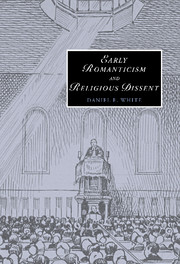Book contents
- Frontmatter
- Contents
- List of illustrations
- Acknowledgments
- Frequently cited texts
- Epigraph
- Introduction
- 1 “True Principles of Religion and Liberty”: liberal Dissent and the Warrington Academy
- 2 Anna Barbauld and devotional tastes: extempore, particular, experimental
- 3 The “Joineriana”: Barbauld, the Aikin family circle, and the Dissenting public sphere
- 4 Godwinian scenes and popular politics: Godwin, Wollstonecraft, and the legacies of Dissent
- 5 “Properer for a Sermon”: Coleridgean ministries
- 6 “A Saracenic mosque, not a Quaker meeting-house”: Southey's Thalaba, Islam, and religious nonconformity
- 7 Conclusion
- Notes
- Bibliography
- Index
- CAMBRIDGE STUDIES IN ROMANTICISM
4 - Godwinian scenes and popular politics: Godwin, Wollstonecraft, and the legacies of Dissent
Published online by Cambridge University Press: 22 September 2009
- Frontmatter
- Contents
- List of illustrations
- Acknowledgments
- Frequently cited texts
- Epigraph
- Introduction
- 1 “True Principles of Religion and Liberty”: liberal Dissent and the Warrington Academy
- 2 Anna Barbauld and devotional tastes: extempore, particular, experimental
- 3 The “Joineriana”: Barbauld, the Aikin family circle, and the Dissenting public sphere
- 4 Godwinian scenes and popular politics: Godwin, Wollstonecraft, and the legacies of Dissent
- 5 “Properer for a Sermon”: Coleridgean ministries
- 6 “A Saracenic mosque, not a Quaker meeting-house”: Southey's Thalaba, Islam, and religious nonconformity
- 7 Conclusion
- Notes
- Bibliography
- Index
- CAMBRIDGE STUDIES IN ROMANTICISM
Summary
By the mid 1790s, the Dissenting public sphere as lived and represented by liberal Dissenters had begun to dissipate. Three years before his permanent departure in 1794 for the banks of the Susquehanna, Joseph Priestley complained that “rational Dissenters … are dwindling away almost everywhere,” and by the middle of the decade the representative figures of Dissenting social and intellectual life, such as Priestley, Richard Price, Timothy Hollis, and Robert Robinson, had either died or emigrated. Furthermore, the principal heterodox Dissenting academies throughout England had closed their doors: Hoxton folded in 1785, Warrington in 1786, Daventry in 1789, and the New College in Hackney in 1796. The Dissenting public sphere thus gradually lost its focused and progressive identity, and rational Dissenters would not project such a coherent public front again until the renewed outburst of propaganda against the Corporation and Test Acts in the 1820s. After 1795, a major year of mortality for prominent members of the nonconformist community, liberal Dissent became increasingly retrospective: The Protestant Dissenter's Magazine, published monthly from January 1794 to December 1799 “with the Assistance of several Dissenting Ministers of the Three Denominations,” can be read as an epitaph to the active phase of late-eighteenth-century Dissenting public life. Consisting mainly of “Biographical Memoirs” and “Ecclesiastical History,” the Magazine memorialized Dissenting preachers, educators, and intellectuals, accompanying their “Memoirs” with engraved portraits.
- Type
- Chapter
- Information
- Early Romanticism and Religious Dissent , pp. 87 - 118Publisher: Cambridge University PressPrint publication year: 2007



